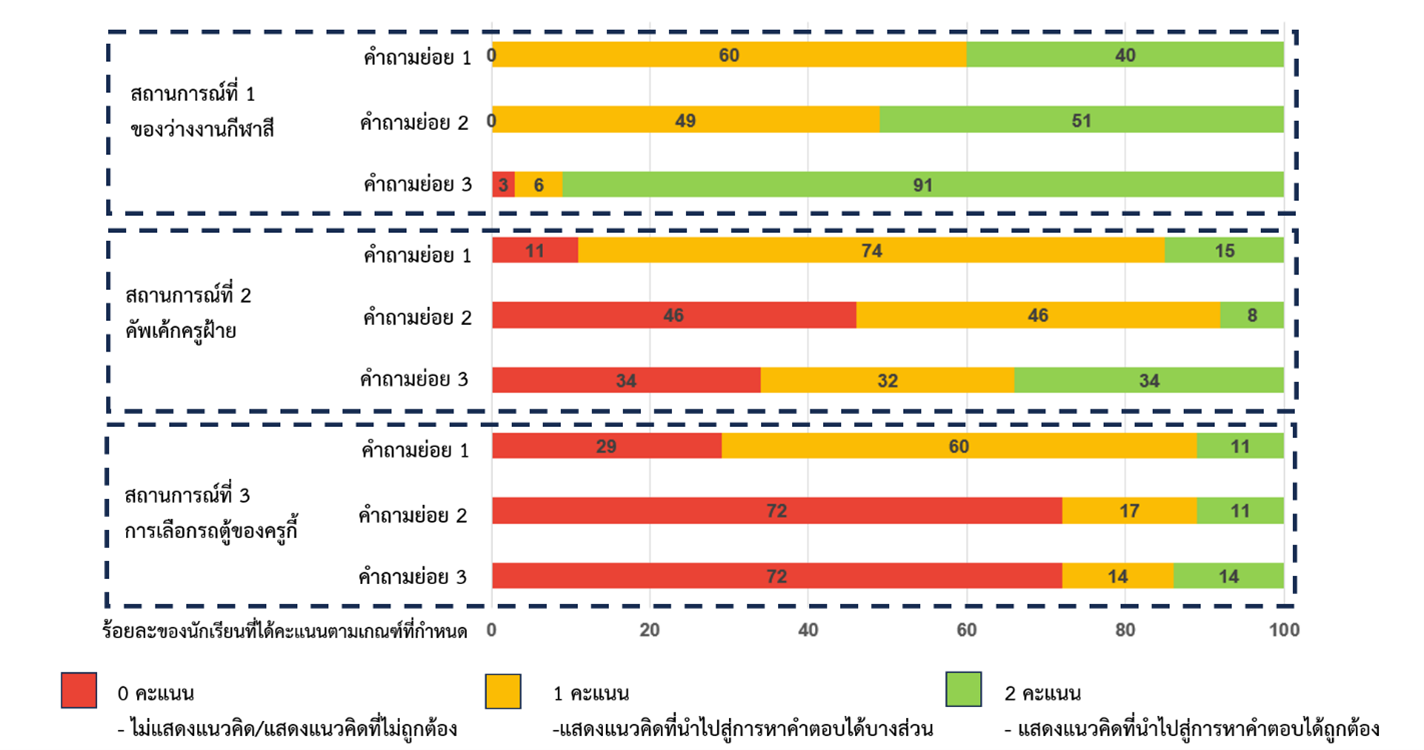Development of Mathematical Tasks for Assessing Mathematical Literacy of Lower-Secondary Students
DOI:
https://doi.org/10.14456/educu.2024.35Keywords:
mathematical task, mathematical literacy, lower-secondary studentAbstract
Assessing students' mathematical literacy requires the use of mathematically specific tasks. This research aimed to: (1) develop principles for task design and a prototype task, and (2) examine the implementation of task in assessing the mathematical literacy of lower-secondary students. The study comprised three phases: preparation and design, task implementation, and retrospective analysis. Participants included mathematics educators, teachers, and students. Research tools encompassed tasks and semi-structured interviews. Data analysis used descriptive statistics (frequency and percentage) and content analysis. The research had two key findings regarding task design and implementation: 1) Task designing involves several crucial aspects, including 1.1) Tasks should be relevant to students' lives and spark their interest. 1.2) The questions within the task should flow logically and build upon one another. 1.3) Collaboration among educators and other stakeholders in designing tasks leads to more comprehensive assessments. And, 1.4) Scoring criteria should be clear, concise, and easy for educators to apply. 2) The task implementation revealed that while most students could formulate mathematically, some faced challenges in employing, interpreting, and evaluating their responses within the context of the questions. These findings provide insights for collaborative mathematical task creation for appropriately assess students' mathematical literacy in real contexts.
References
ภาษาไทย
กระทรวงศึกษาธิการ. (2560). ตัวชี้วัดและสาระการเรียนรู้แกนกลางกลุ่มสาระการเรียนรู้คณิตศาสตร์ (ฉบับปรับปรุง พ.ศ. 2560) ตามหลักสูตรแกนกลางการศึกษาขั้นพื้นฐาน พุทธศักราช 2551. กรุงเทพฯ: โรงพิมพ์ชุมนุมสหกรณ์การเกษตรแห่งประเทศไทย.
ฉวีวรรณ แก้วไทรฮะ และ สุพจน์ ไชยสังข์. (2557). การวิเคราะห์การสอบพิซ่าและโอเน็ตของสถาบัน ทดสอบการศึกษาแห่งชาติเพื่อปฏิรูปการเรียนการสอนวิชาคณิตศาสตร์. มหาวิทยาลัยราชภัฎสวนสุนันทา. https://backoffice.niets.or.th/th/content/view/304
สกล ตั้งเก้าสกุล, ทรงชัย อักษรคิด, วันดี เกษมสุขพิพัฒน์ และ ชนิศวรา เลิศอมรพงษ์. (2566). การวิเคราะห์ลักษณะสำคัญของงานสร้างแบบจำลองทางคณิตศาสตร์ที่ออกแบบโดยนักศึกษาครูคณิตศาสตร์. วารสารพัฒนาการเรียนการสอน มหาวิทยาลัยรังสิต, 17(2), 251-266.
สถาบันส่งเสริมการสอนวิทยาศาสตร์และเทคโนโลยี. (2563, 21 มิถุนายน). PISA 2021 กับการประเมินความฉลาดรู้ด้านคณิตศาสตร์. https://pisathailand.ipst.ac.th/issue-2020-53
สำนักงานเลขาธิการสภาการศึกษา. (2560). แผนการศึกษาแห่งชาติ พ.ศ. 2560 – 2579. กรุงเทพฯ: พริกหวานกราฟฟิค จำกัด.
สุนีย์ คล้ายนิล. (2558). การศึกษาคณิตศาสตร์ในระดับโรงเรียนไทย : การพัฒนา - ผลกระทบ - ภาวะถดถอยในปัจจุบัน. สถาบันส่งเสริมการสอนวิทยาศาสตร์และเทคโนโลยี. https://drive.google.com/file/d/0BwqFSkq5b7zSWUduVm1XWVVIdlk/view?resourcekey=0-8oYRqf55pvEzmooqmTAtNg
สุวิมล ว่องวาณิช. (2563). การวิจัยการออกแบบทางการศึกษา. กรุงเทพฯ: สำนักพิมพ์จุฬาลงกรณ์มหาวิทยาลัย.
ภาษาอังกฤษ
Bakker, A. (2018). Design research in education: A practical guide for early career researchers. Routledge.
Blum, W. (2015). Quality Teaching of Mathematical Modelling: What Do We Know, What Can We Do?. In: Cho, S. (Eds.), The Proceedings of the 12th International Congress on Mathematical Education (pp. 73-96). Springer, Cham. https://doi.org/10.1007/978-3-319-12688-3_9
Bonotto, C. (2007). How to Replace Word Problems with Activities of Realistic Mathematical Modelling. In: Blum, W., Galbraith, P.L., Henn, HW., Niss, M. (Eds.), Modelling and Applications in Mathematics Education (pp. 185-192). New ICMI Study Series, vol 10. Springer, Boston, MA. https://doi.org/10.1007/978-0-387-29822-1_18
Borromeo Ferri, R. (2018). Learning how to teach mathematical modeling in school and teacher education. Switzerland: Springer International Publishing.
Crespo, S. (2003). Learning to pose mathematical problems: Exploring changes in preservice teachers' practices. Educational Studies in Mathematics, 52(3), 243-270.
Galbraith, P. (2006). Real world problems: Developing principles of design. In P. Grootenboer, R. Zevenbergen & M. Chinnappan (Eds.), 29th annual conference of the mathematics education research group of Australasia: Identities, cultures and learning spaces (Vol. 1, pp. 229–236). Canberra: MERGA.
Goos, M., Vale, C., Stillman, G., Makar, K., Herbert, S., & Geiger, V. (2020). Teaching secondary school mathematics: Research and practice for the 21st century. Routledge.
Kaiser, G. (2020). Mathematical modelling and applications in education. In S. Lerman (Ed.), Encyclopedia of Mathematics Education (pp. 553–561). Second edition. Springer.
Maaß, K. (2010). Classification scheme for modelling tasks. Journal für Mathematik-Didaktik, 31(2), 285-311.
OECD. (2018, July 21). PISA 2021 Mathematics Framework (Second Draft). https://pisa2022-maths.oecd.org/files/PISA%202022%20Mathematics%20Framework%20Draft.pdf
Stacey, K., & Turner, R. (2014). Assessing mathematical literacy. Springer International Publishing AG.
Tangkawsakul, S., Thaikam, W. & Ugsonkid, S. (2024). Bridging Gaps: Pre-Service Mathematics Teachers’ Handling the Difficulties in Posing Real-World Mathematical Problems. Journal of Education and Learning. 13(3), 133-143. https://doi.org/10.5539/jel.v13n3p133

Downloads
Published
How to Cite
Issue
Section
License

This work is licensed under a Creative Commons Attribution-NonCommercial-NoDerivatives 4.0 International License.



